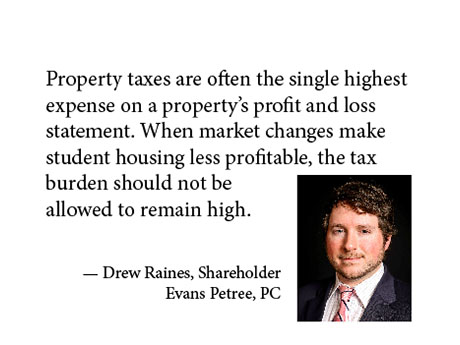Not long ago, assessors’ student housing properties valuations generally struggled keeping pace with the rising market. College enrollment was high, rent growth outpaced expenses and student expectations lined up with most newer facility amenities. However, the COVID-19 pandemic and its fallout changed the game.
Property taxes are often the single highest expense on a property’s profit and loss statement. When market changes make student housing less profitable, the tax burden should not be allowed to remain high. When this occurs, the assessor’s property valuation needs to be challenged and reduced.
Projecting Income: Look Forward, Not Back
Many jurisdictions assess student housing properties’ value using a cost approach. A computer system estimates the cost to build the property new, then deducts physical depreciation based on the property’s age. Due to skyrocketing construction costs, those depreciation deductions are outpaced by base cost increases. It is common to see cost-based values increase despite struggles facing the real estate market. Owners can combat increases by appealing the assessor’s value.
When a student housing property owner files an assessment appeal, the appeal review board often evaluates the three prior years’ operating income. This allows the appeal board to develop an income model intended to represent stabilized operations. Then the net income is capitalized, producing an estimated market value. When the market rises and rent increases, looking at the past three year’s performance is probably a favorable method for taxpayers. However, in a flat or falling market, determining value based on past success proves unfair. Property values’ steady upward trajectory, by and large, has stalled out given the gut-punch of 2022 interest rate hikes. Capitalization rates have risen along with the interest rates, though it becomes difficult to see clearly because sales transaction volume slowed to a trickle. Sellers would rather sit on their property than swallow the loss the current market forced on them.
For student housing specifically, it is not uncommon for brokers to cite 15 percent to 20 percent market value declines from early 2022 to early 2023. In addition to general market woes, some developers expect college enrollment to drop in the near future due, in part, to fewer students graduating from high school. This will make leasing more difficult and put downward pressure on rents and occupancy. Falling rental income should be taken into consideration by the board or tribunal hearing a property tax appeal.
Projecting Expenses: The Compounding Costs of COVID
Waves of new development during the late 1990s and mid-2010s saw student housing units grow exponentially. At the time, they were state-of-the-art facilities with all the amenities a student could desire. For some, common areas evolved from utilitarian waiting rooms to shared workspaces or workout gyms. For others, bathrooms were no longer shared with a full suite, but only a single roommate.
When the property’s design fails to meet changing tenant expectations, that produces functional obsolescence. Many boom-time properties now suffer functional obsolescence. Worrisome trends that predated COVID-19 have been fast-tracked by the pandemic, becoming major problems.
Most people, including future college students, were quarantined for months and developed new tastes and behaviors. Student tenants are not as tolerant of sharing a bathroom with a roommate. One-to-one bathrooms are no longer a luxury in most markets, but trying to retro-fit a property to achieve the best bed-to-bath ratio often fails the cost-benefit analysis. When a design deficiency can’t feasibly be corrected, it is known as incurable functional obsolescence.
Online shopping became a near-necessity during quarantine, reshaping our consumer habits long-term. When a building full of button-clicking students receives more Amazon boxes than envelopes, there better be package lockers or another delivery management system to handle the volume. Maybe some under utilized common area space presents an easy opportunity to convert, making this type of obsolescence curable. Even so, the cure does not come without landlord expense.
Not all new expenses involve obsolete building design. New cleaning protocols originated during the pandemic but have not receded with the COVID case count. The “janitorial” line item has swollen, further narrowing landlord margins.
Even if the building is clean, it may not be tidy. Kids who were forced to stay home for meals tend not to go out as frequently. They order-in, and they party-in, too. That creates a lot of trash. Kids do not appreciate having to haul trash down a flight of stairs or ride with it down an elevator. Trash chutes appease them, but not if the building doesn’t have one.
Rising operating costs are not all associated with COVID. For example, HVAC systems that use a coolant being phased out by new regulations will have to be upgraded to comply. Also, insurance, payroll, and other outside service costs have increased with general inflation.
Increasing operating expenses drive down a property’s net income and should be accounted for by tax appeal decision-makers.
Question the Assessor’s Valuation
When property owners appeal their assessment based on a drop in income, “bad management” becomes the common refrain heard from assessors. This implies the property is worth more than the income indicates, because it has been poorly operated. Sometimes this is true, but if a property suffers lackluster performance caused by unavoidable market changes, the assessment should account for that. Taxpayers would be wise to seek seasoned property tax counsel for advice as to what relief may be available.
—Drew Raines is a shareholder in the Memphis law firm of Evans Petree, PC, the Arkansas and Tennessee member of American Property Tax Counsel, the national affiliation of property tax attorneys. He can be reached at draines@evanspetree.com.


